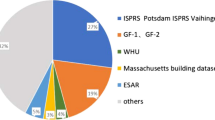Abstract
In order to improve the accuracy of regional image confidence propagation calculation, a regional image confidence propagation algorithm based on deep learning is designed. Firstly, the relevant information is collected, and then the data similarity is calculated. Finally, the regional image confidence propagation algorithm based on deep learning is calculated. The experimental results show that the regional image confidence propagation algorithm based on deep learning improves the calculation accuracy and reduces the calculation time.
Access this chapter
Tax calculation will be finalised at checkout
Purchases are for personal use only
Similar content being viewed by others
References
Tom, Y., Devamanyu, H., Soujanya, P., et al.: Recent trends in deep learning based natural language processing [review article]. IEEE Comput. Intell. Mag. 13(3), 55–75 (2018)
Sun, X., Wu, P., Hoi, S.C.H.: Face detection using deep learning: an improved faster RCNN approach. Neurocomputing 299(19), 42–50 (2018)
Supriya, S., Subaji, M.: Deep learning the features maps for automated tumor grading of lung nodule structures using convolutional neural networks. Intell. Decis. Technol. 14(1), 1–18 (2020)
Dreizin, D., Zhou, Y., Zhang, Y., et al.: Performance of a deep learning algorithm for automated segmentation and quantification of traumatic pelvic hematomas on CT. J. Digit. Imaging 33(1), 1–9 (2019)
Li, Z.M., Gui, W.H., Zhu, J.Y.: Fault detection in flotation processes based on deep learning and support vector machine. J. Cent. South Univ. 26(9), 2504–2515 (2019)
Altaheri, H., Alsulaiman, M., Muhammad, G.: Date fruit classification for robotic harvesting in a natural environment using deep learning. IEEE Access 7(1), 117115–117133 (2019)
Hu, D., Zhang, Y., He, L., et al.: Low-complexity deep-learning-based DOA estimation for hybrid massive MIMO systems with uniform circular arrays. IEEE Wirel. Commun. Lett. 9(1), 83–86 (2020)
Pathirage, C.S.N., Li, J., Li, L., et al.: Development and application of a deep learning-based sparse autoencoder framework for structural damage identification. Struct. Health Monit. 18(1), 103–122 (2019)
Bao, Y., Tang, Z., Li, H., et al.: Computer vision and deep learning-based data anomaly detection method for structural health monitoring. Struct. Health Monit. 18(2), 401–421 (2019)
Ho, K.K., Gwak, J.: Toward deep learning approaches for learning structure motifs and classifying biological sequences from RNA A-to-I editing events. IEEE Access 7(99), 127464–127474 (2019)
Liu, S., Liu, D., Srivastava, G., et al.: Overview and methods of correlation filter algorithms in object tracking. Complex Intell. Syst. (2020). https://doi.org/10.1007/s40747-020-00161-4
Fu, W., Liu, S., Srivastava, G.: Optimization of big data scheduling in social networks. Entropy 21(9), 902 (2019)
Liu, S., Glowatz, M., Zappatore, M., et al. (eds.): e-Learning, e-Education, and Online Training, pp. 1–374. Springer International Publishing, Cham (2018). https://doi.org/10.1007/978-3-319-93719-9
Atmane, K., Hongbin, M., Qing, F.: Convolutional neural network based on extreme learning machine for maritime ships recognition in infrared images. Sensors 18(5), 1490 (2018)
Park, Y., Yang, H.S.: Convolutional neural network based on an extreme learning machine for image classification. Neurocomputing 339, 66–76 (2019)
Liu, B., Xie, Y., Yuan, J.: A deep learning assisted node-classified redundant decoding algorithm for BCH codes. IEEE Trans. Commun. PP(99), 1 (2020)
Sourati, J., Gholipour, A., Dy, J.G., et al.: Intelligent labeling based on fisher information for medical image segmentation using deep learning. IEEE Trans. Med. Imaging 38, 2642–2653 (2019)
Qian, T., Zhu, H., et al.: High temperature dielectric properties measurement system at 915? MHz based on deep learning. Int. J. RF Microw. Comput.-Aided Eng. 29(11), e21948 (2019)
Horisaki, R., Takagi, R., Tanida, J.: Deep-learning-generated holography. Appl. Opt. 57(14), 3859 (2018)
Peixoto, S.A., Medeiros, A.G., Hassan, M.M., et al.: Floor of log: a novel intelligent algorithm for 3D lung segmentation in computer tomography images. Multimedia Syst. (2), 1–13 (2020)
Yang, Y., Yang, Z., Yu, J., et al.: Fast calculation of probabilistic power flow: a model-based deep learning approach. IEEE Trans. Smart Grid PP(99), 1 (2019)
Geetha, A., Gomathi, N.: A robust grey wolf-based deep learning for brain tumour detection in MR images. Biomed. Eng./Biomedizinische Technik 65(2), 191–207 (2020)
Li, X., Huang, H., Zhao, H., et al.: Learning a convolutional neural network for propagation-based stereo image segmentation. Vis. Comput. 36(1), 39–52 (2020)
Duan, S., Yu, S., Chen, Y., et al.: On kernel method-based connectionist models and supervised deep learning without backpropagation. Neural Comput. 32(1), 1–39 (2019)
Yabin, G., Zehan, T., Huanxin, C., et al.: Deep learning-based fault diagnosis of variable refrigerant flow air-conditioning system for building energy saving. Appl. Energy 225, 732–745 (2018)
Park, E., Moon, Y.J., Lim, D., et al.: De-noising SDO/HMI solar magnetograms by image translation method based on deep learning. Astrophys. J. Lett. 891(1), L4 (2020). (9pp)
Kriegeskorte, N., Golan, T.: Neural network models and deep learning. Curr. Biol. 29(7), R225–R240 (2019)
Gautam, A., Singh, V.: CLR-based deep convolutional spiking neural network with validation based stopping for time series classification. Appl. Intell. 50(3), 830–848 (2020)
Author information
Authors and Affiliations
Editor information
Editors and Affiliations
Rights and permissions
Copyright information
© 2021 ICST Institute for Computer Sciences, Social Informatics and Telecommunications Engineering
About this paper
Cite this paper
Qian, J., Wang, Ll., Huang, Hy. (2021). A New Confidence Propagation Algorithm for Regional Image Based on Deep Learning. In: Fu, W., Xu, Y., Wang, SH., Zhang, Y. (eds) Multimedia Technology and Enhanced Learning. ICMTEL 2021. Lecture Notes of the Institute for Computer Sciences, Social Informatics and Telecommunications Engineering, vol 388. Springer, Cham. https://doi.org/10.1007/978-3-030-82565-2_37
Download citation
DOI: https://doi.org/10.1007/978-3-030-82565-2_37
Published:
Publisher Name: Springer, Cham
Print ISBN: 978-3-030-82564-5
Online ISBN: 978-3-030-82565-2
eBook Packages: Computer ScienceComputer Science (R0)




